Ekstrak Daun Cocor Bebek (Kalanchoe pinnata) untuk Terapi Preventif Lupus pada Mencit yang Diinduksi dengan 2,6,10,14 Tetramethylpentadecane
DOI:
https://doi.org/10.30872/jtpc.v1i3.234Keywords:
Cocor bebek, BALB/c mice, lupus, TMPD, glomerulo nefritisAbstract
Cocor bebek Plants (Kalanchoe pinnata) has been observed to have a potent immunosuppressant compounds in BALB/c mice with Delayed Type Hypersensitivity test (DTH). Compounds are efficacious immunosuppression can be used for treatment of autoimmune diseases such as lupus. The purpose of this study was knowing the class of compounds in leaf extracts cocor bebek and test whether the extract can prevent the occurrence of lupus in test animals. Methods: In this study the identification of classes of compounds present in Cocor bebek leaf extracts and testing imunnosupression activities from test animals BALB/c mice induced lupus using 2,6,10,14 tetramethylpentadecane (TMPD). Parameters measured lupus glomerulonephritis which was known by the presence of proteinuria using a test strip supported by data on changes in weight. Results: Extracts of cocor bebek leaves positive contain tannins, flavonoids, saponins and steroid / triterpene. Mice given the extract of Cocor bebek leaves every day until the 3rd month after not having induced proteinuria, while untreated mice had proteinuria up to +2 (proteinuria levels> 30 mg / dL).
Downloads
References
Almeida. 2006, 1-Octen-3-O-α-L arabinopyranosyl(1→6)βglucopyrano-side, a minor substance from the leaves of Kalanchoe pinnata(Crassulaceae), Brazilian Journal of Pharmacognosy, 16(4): 485-489, Out./Dez. 2006.
Bergmann et.al. 1994, Immuno-suppressive Effect of the Aqueous Extract of Kalanchoe pinnata in mice, journal: Phytotherapy Research, VOL. 8, 399-402 (1994).
Chae, B.S.; Kim, D.K.; Eun, J.S.; Kwon, G.S.; & Shin, T.Y. 2010,The Inhibitory Effect of Bamboo Culm Extract on the Development of Pulmonary Inflammation in Pristane-Induced Lupus Mice, Natural Product Sciences, 16(4), 245-250.
DiPiro, J.T.; et. al. 2005, Pharmacotherapy : A Patophysiologic Approach, 6th ed., Mc-Graw-Hill, New York.
National Institutes of Health. 2007,The Future Directions of Lupus Research, U.S. Department of Health and Human Services.
Peterson, N.C. 2000,Behavioral, Clinical, and Physiological Analysis of Mice Used for Ascites Monoclonal AntibodyProduction, Comparative Medicine50(5): 516-526.
Satoh, Minoru & Westley H. Reeves. 1994,Induction of Lupus-associated Autoantibodies in BALB/c Mice by Intraperitoneal Injection of Pristane, Journal, Departments of Medicine and Microbiology /Immunology,University of North Carolina, North Carolina, 1994.
Reeves, et.al.2009,Induction of Autoimmunity by Pristane and Other Naturally Occuring hydrocarbons, Trends Immunol.
Wallace, D.J. 2005,The Lupus Book: A Guide for Patients and Their Families, 3rd ed., Oxford University Press, New York.
World Health Organization. 2009,Medicinal Plants in Papua New Guinea, Part 1, Regional Office for the Western Pacific, Manila, Philippines, 2009; page 49.
Vogel. 2002, Drug Discovery and Evaluation, 2nd Ed., Springer‐Verlag Berlin Heidelberg, Germany.




